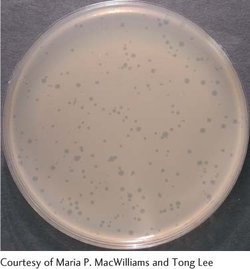Techniques for the Study of Bacteriophages
Viruses reproduce only within host cells, so bacteriophages must be cultured in bacterial cells. Phages can be grown in large liquid cultures of bacteria to generate large numbers of offspring, but to study the characteristics of individual phages, we must isolate them on petri plates. Phages and bacteria are mixed together and plated on solid medium on a petri plate. A high concentration of bacteria is used so that the colonies will grow into one another and produce a continuous layer of bacteria, or “lawn,” on the agar. An individual phage infects a single bacterial cell and goes through its lytic cycle. Many new phages are released from the lysed cell and infect additional cells; the cycle is then repeated. Because the bacteria are growing on solid medium, the diffusion of the phages is restricted, so only nearby cells are infected. After several rounds of phage reproduction, a clear patch of lysed cells, or plaque, appears on the plate (Figure 7.21). Each plaque represents a single phage that multiplied and lysed many cells. Plating a known volume of a dilute solution of phages on a bacterial lawn and counting the number of plaques that appear can be used to determine the original concentration of phages in the solution.

CONCEPTS
Viral genomes may be DNA or RNA, circular or linear, and double or single stranded. Bacteriophages are used in many types of genetic research.
 CONCEPT CHECK 5
CONCEPT CHECK 5
In which bacteriophage life cycle does the phage DNA become incorporated into the bacterial chromosome?
Lytic
Lysogenic
Both lytic and lysogenic
Neither lytic or lysogenic
b